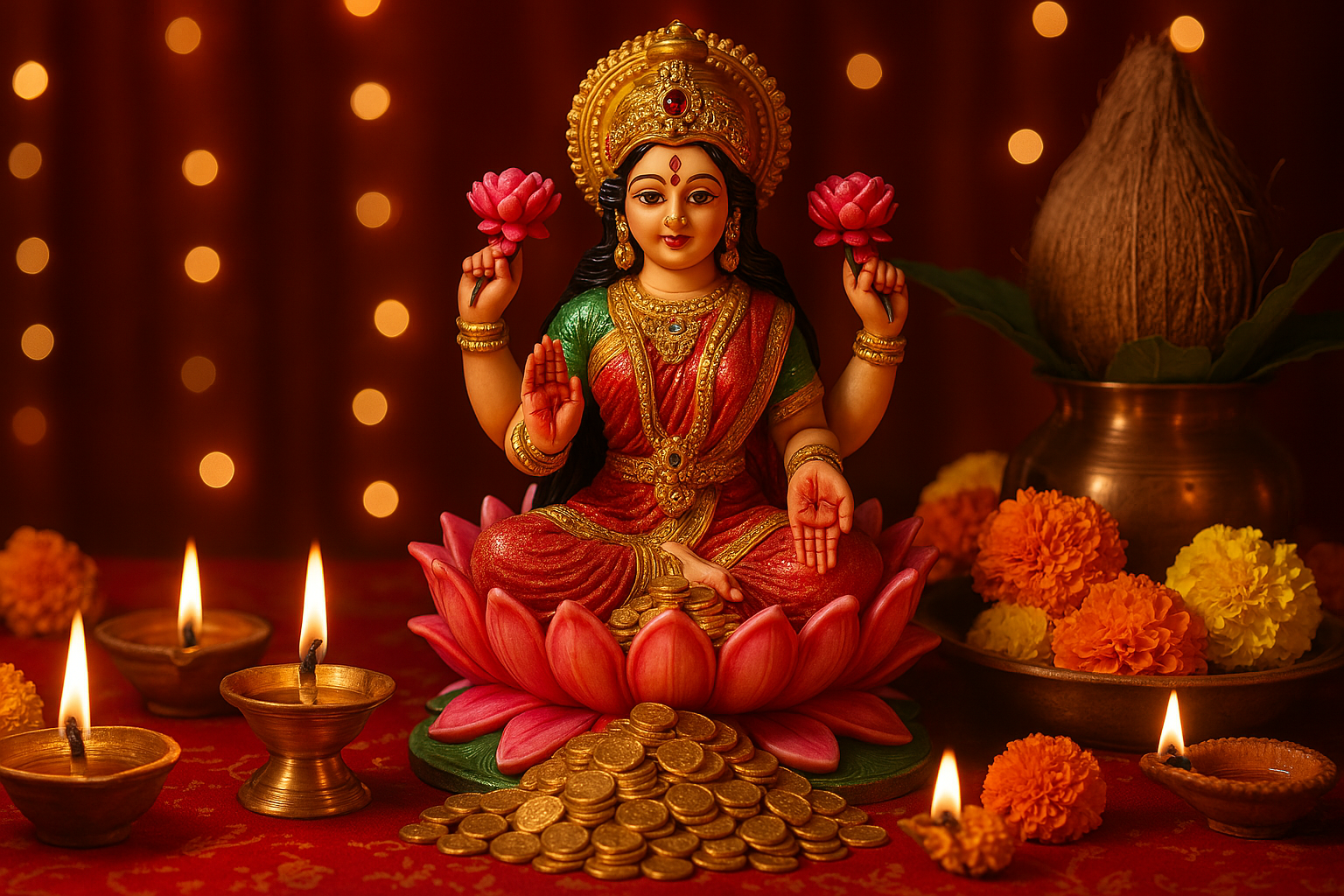Lakshmi Puja is a Hindu festival dedicated to the worship of Goddess Lakshmi, the deity of wealth, prosperity, and fortune. This festival is an integral part of Diwali, the grand festival of lights celebrated across India and various parts of the world. Lakshmi Puja is observed with great enthusiasm, where devotees seek blessings for prosperity, happiness, and well-being. The celebration involves elaborate rituals, prayers, and offerings to honor the goddess, symbolizing the triumph of light over darkness and good over evil.
Article Contents
Significance of Lakshmi Puja
Goddess Lakshmi is one of the principal deities in Hinduism and is revered as the consort of Lord Vishnu. She represents material and spiritual wealth, and her blessings are sought by individuals and businesses alike. According to Hindu mythology, during Samudra Manthan (the churning of the ocean), Goddess Lakshmi emerged from the ocean, bringing wealth and fortune to the gods and humanity.
Lakshmi Puja holds immense significance in Hindu households and commercial establishments. It is believed that on the night of Diwali, Goddess Lakshmi visits homes that are clean, well-lit, and filled with devotion. This belief encourages people to decorate their houses with lights, rangoli (colorful patterns made on the floor), and flowers to welcome the goddess.
When is Lakshmi Puja in 2025
Lakshmi Puja is performed on the third day of Diwali, known as Amavasya (new moon day) in the Hindu lunar month of Kartika (October-November). The timing of the puja is determined based on the auspicious muhurat (specific time) calculated according to the Hindu Panchang (calendar). Performing the rituals during the pradosh kaal (early evening) is considered most auspicious.
Preparations for Lakshmi Puja
The preparations for Lakshmi Puja begin days in advance. Devotees clean and decorate their homes to invite prosperity and good fortune. Here are some essential aspects of the preparation:
- Cleaning and Decoration: Cleaning the house is considered a way to remove negative energies and make the environment pure for the arrival of Goddess Lakshmi. After cleaning, homes and offices are decorated with diyas (oil lamps), candles, fairy lights, and rangoli.
- Setting Up the Altar: A small altar or puja space is arranged with an idol or image of Goddess Lakshmi, along with Lord Ganesha, who is worshipped for wisdom and the removal of obstacles. A kalash (sacred pot) filled with water, mango leaves, and a coconut is placed as a symbol of prosperity.
- Offering and Prasad: Various offerings, including sweets, fruits, flowers, and coins, are placed in front of the goddess. Special sweets like ladoo, kheer, and pedas are prepared as prasad (sacred food offering).
- Dressing Up: People wear traditional attire, with women adorning sarees and men wearing kurta-pajamas. Some also buy new clothes as a symbol of prosperity.
Rituals of Lakshmi Puja
The puja is performed with great devotion and follows a structured sequence of rituals. The main steps involved in Lakshmi Puja are:
- Sankalpa (Vow and Invocation): Devotees take a vow to perform the puja with sincerity and invite Goddess Lakshmi to their homes.
- Ganesha Puja: Lord Ganesha is worshipped first to remove obstacles and bless the occasion.
- Kalash Sthapana (Setting Up the Sacred Pot): A kalash is placed with water, betel leaves, a coconut, and flowers, symbolizing purity and abundance.
- Lakshmi Aarti and Stotra Recitation: Hymns, prayers, and the Lakshmi Stotra are chanted to seek divine blessings. The most popular aarti sung is Om Jai Lakshmi Mata.
- Offering Flowers and Diyas: Devotees offer flowers, light diyas, and incense sticks to the goddess, symbolizing the removal of darkness and ignorance.
- Naivedya and Prasad Distribution: After the prayers, sweets and food items are offered to the deity and later distributed among family members and guests.
Cultural Variations and Regional Celebrations
Lakshmi Puja is celebrated differently across various regions of India and the world. Some of the distinct traditions include:
- North India: In states like Uttar Pradesh, Rajasthan, and Delhi, Lakshmi Puja is the main festival of Diwali. Businesses close their accounts for the year and start new ledgers, a ritual called Chopda Pujan.
- West India: In Maharashtra and Gujarat, the festival is marked by Kuber Lakshmi Puja, where traders and shopkeepers seek financial prosperity.
- East India: In Bengal, Lakshmi Puja is celebrated separately from Diwali, usually on Sharad Purnima, and is known as Kojagari Lakshmi Puja.
- South India: In Tamil Nadu and Karnataka, the puja is performed alongside other Diwali festivities, with a focus on lighting lamps and preparing festive delicacies.
Modern Observance and Global Influence
In modern times, Lakshmi Puja has gained prominence beyond India. With the Indian diaspora spreading worldwide, the festival is celebrated in countries like the United States, Canada, the United Kingdom, and Australia. Many temples and Indian communities organize grand Lakshmi Puja events, bringing people together in devotion and cultural celebration.
Conclusion
Lakshmi Puja is a festival that embodies the essence of wealth, prosperity, and devotion. It brings families and communities together in prayer, gratitude, and celebration. By honoring Goddess Lakshmi with faith and dedication, devotees hope to attract success and happiness into their lives. Whether performed at home, in businesses, or in temples, the rituals of Lakshmi Puja continue to be a beacon of spiritual and material fulfillment, ensuring that the traditions of this beautiful festival endure for generations to come.
Related Topics
-
Lakshmi Puja: The Festival of Prosperity and Devotion
Lakshmi Puja is a Hindu festival dedicated to the worship of Goddess Lakshmi, the deity of wealth, prosperity, and fortune. This festival is an integral part of Diwali,…
-
Radha Ashtami: The Auspicious Celebration of Srimati Radharani’s Birth
Article ContentsWhen is Radha Ashtami in 2025?The Importance of Srimati Radharani in VaishnavismThe Celebration of Radha Ashtami in BangladeshSpiritual and Philosophical SignificanceConclusion When is Radha Ashtami in 2025?…
-
Buddha Purnima: The Most Sacred Buddhist Festival in Bangladesh
Article ContentsWhat is Buddha Purnima?Historical Background of Buddhism in BangladeshReligious SignificanceBuddha Purnima Celebrations in BangladeshSpecial Rituals and OfferingsGovernment and Public ObservanceBuddha Purnima Beyond BangladeshBuddha’s Teachings and Their Relevance…
-
Janmashtami: The Birth Celebration of Lord Krishna
Article ContentsWhat is JanmashtamiThe Significance of JanmashtamiHow Janmashtami is CelebratedRegional Variations in Janmashtami CelebrationsSpiritual Lessons from JanmashtamiFrequently Asked Questions (FAQs) About Janmashtami What is Janmashtami Janmashtami, also known…
-
International Mother Language Day: Celebrating Linguistic and Cultural Diversity
Article ContentsOrigins of International Mother Language DayThe Importance of Linguistic DiversityHow to Celebrate International Mother Language DayHow does technology help in preserving languages?Challenges and the Way ForwardConclusionFrequently Asked…






